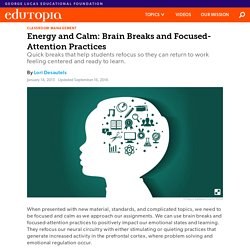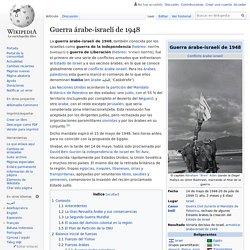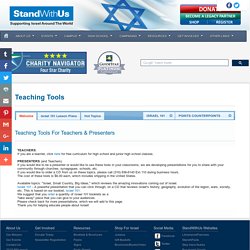Orlya
Orly
Portafolio de Orly Adler
Herramientas 2.0. Bienvenidos a Eduteka. Energy and Calm: Brain Breaks and Focused-Attention Practices. When presented with new material, standards, and complicated topics, we need to be focused and calm as we approach our assignments.

We can use brain breaks and focused-attention practices to positively impact our emotional states and learning. They refocus our neural circuitry with either stimulating or quieting practices that generate increased activity in the prefrontal cortex, where problem solving and emotional regulation occur. Brain Breaks A brain break is a short period of time when we change up the dull routine of incoming information that arrives via predictable, tedious, well-worn roadways. Our brains are wired for novelty.
When we take a brain break, it refreshes our thinking and helps us discover another solution to a problem or see a situation through a different lens. The Junk Bag: I always carry a bag of household objects containing markers, scrap paper, and anything that one would find in a junk drawer—for example, a can opener or a pair of shoelaces.
ClassDojo for Teachers. Chapter 10: Consequences - Conscious Discipline. Consequences teach children to examine their behavior, reflect on the impact of their choices and make changes until they reach their highest goals.

Attention: The ability to sustain attention in spite of distractibility, boredom or fatigue. Time Management: The capacity to estimate how much time one has, how to allocate it, and how to stay within time limits and deadlines. A sense that time is important. Organization: The ability to create and maintain systems to keep track of information or materials.
Prioritization: The ability to see what is most important and make a plan to accomplish it. Working Memory: The ability to hold information in memory while performing complex tasks, and the ability to draw on past learning or experiences to apply to the situation at hand or project into the future. Impulse Control: The capacity to think before you act, allowing you to evaluate a situation and how your behavior might impact it.
Conscious Discipline. Teaching Strategies. Facing History and Ourselves. 150 herramientas gratuitas para crear materiales didácticos on line – juandon. Innovación y conocimiento. Más de 150 herramientas gratuitas para crear materiales didácticos on line Generadores de cuadernos, libros y publicaciones digitales Cuadernia online (Consejería de Educación y Ciencia de Castilla-La Mancha).

Herramienta fácil y funcional para la creación y difusión de materiales educativos digitales. Permite crear de forma dinámica y visual cuadernos digitales que pueden contener información y actividades multimedia. Tal vez también te interese visitar el portal de recursos de Cuadernia donde encontrarás diversas versiones de esta herramienta para descargar tutoriales, un foro, novedades, actividades, etc.Tikatok es una aplicación en línea que permite de forma muy sencilla la creación de libros virtuales que contengan imágenes y textos.
Teaching Strategies. "Conectivismo".
RubiStar Home. El aprendizaje colaborativo en el aula. Didaktiska tips. Desarrollo moral. דפי תרגול לכתיבת אותיות בכתב יד « הרהורים על משפחה וילדים. תשבצים, תשחצים, תשבצים להדפסה, תשחצים קלים לילדים, תפזורות לילדים, חידונים לחגים, תפזורות לחגים. Mikranet.org. הלול - דפי עבודה: אותיות האלף בית בכתב. מחולל תשבצים. The Ivrix Project - Spell Checker. Yadvashem. Recursos en español — United States Holocaust Memorial Museum. Yad Vashem - The World Holocaust Remembrance Center. Home. Jacob Richman's Home Page. The Lookstein Center for Jewish Education. StandWithUs Resources. Since 2001 StandWithUs has produced groundbreaking resources for students, community members, and the general public to use in promoting and defending Israel.

La guerra árabe-israelí de 1948, también conocida por los israelíes como guerra de la Independencia (hebreo: מלחמת העצמאות) o guerra de Liberación (hebreo: מלחמת השחרור), fue el primero de una serie de conflictos armados que enfrentaron al Estado de Israel y a sus vecinos árabes, en lo que se conoce globalmente como el conflicto árabe-israelí.

Para los árabes palestinos esta guerra marcó el comienzo de lo que ellos denominan Nakba (en árabe النكبة, ‘Catástrofe’). Las Naciones Unidas acordaron la partición del Mandato Británico de Palestina en dos estados: uno judío, con el 55 % del territorio (incluyendo por completo el desierto del Néguev), y otro árabe, con el resto excepto Jerusalén, que sería considerada zona internacionalizada.
Esta resolución fue aceptada por los dirigentes judíos, pero rechazada por las organizaciones paramilitares sionistas y por los árabes en su conjunto.[10]
Guerra árabe-israelí de 1948. Israel 101 Spanish. StandWithUs Resources » Teaching Tools. U.S. policy has been to assist both Israel and Arab states.

Between 1947 and 1971, U.S. annual aid to Israel was $60 million, while the Arab States received $170 million. After 1970, the U.S. regarded Israel as a valuable strategic ally and increased its aid. It also continued to aid and/or sell arms to Jordan, Morocco, Egypt, Saudi Arabia, Tunisia, Yemen and the Gulf States. The U.S. committed $2 billion/year to Egypt and $3 billion/year to Israel after the Israel-Egypt peace treaty of 1979. The U.S. spends vastly more to protect the security of its other allies than it spends on Israel. Israel uses much of its grant money to purchase military equipment and other items from the U.S., creating jobs in America.
POSTER trasera.






